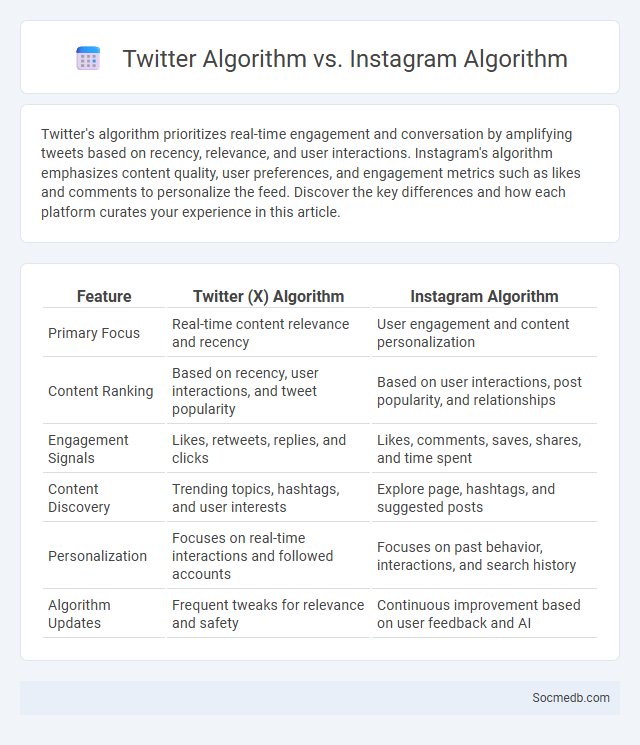
Photo illustration: Twitter Algorithm vs Instagram Algorithm
Twitter's algorithm prioritizes real-time engagement and conversation by amplifying tweets based on recency, relevance, and user interactions. Instagram's algorithm emphasizes content quality, user preferences, and engagement metrics such as likes and comments to personalize the feed. Discover the key differences and how each platform curates your experience in this article.
Table of Comparison
| Feature | Twitter (X) Algorithm | Instagram Algorithm |
|---|---|---|
| Primary Focus | Real-time content relevance and recency | User engagement and content personalization |
| Content Ranking | Based on recency, user interactions, and tweet popularity | Based on user interactions, post popularity, and relationships |
| Engagement Signals | Likes, retweets, replies, and clicks | Likes, comments, saves, shares, and time spent |
| Content Discovery | Trending topics, hashtags, and user interests | Explore page, hashtags, and suggested posts |
| Personalization | Focuses on real-time interactions and followed accounts | Focuses on past behavior, interactions, and search history |
| Algorithm Updates | Frequent tweaks for relevance and safety | Continuous improvement based on user feedback and AI |
Introduction to Social Media Algorithms
Social media algorithms determine the content you see by analyzing your interactions, preferences, and behaviors to deliver personalized experiences. These complex systems prioritize posts, ads, and recommendations based on relevance and user engagement metrics such as likes, shares, comments, and viewing duration. Understanding how these algorithms function can help you optimize your content visibility and engagement on platforms like Facebook, Instagram, and Twitter.
Understanding the Twitter Algorithm
Understanding the Twitter algorithm helps you optimize content visibility by prioritizing relevance, engagement, and recency. The algorithm analyzes user interactions such as likes, retweets, and comments to tailor the timeline, showing you content most likely to interest you. Leveraging hashtags, timely posts, and engaging multimedia increases the chances your tweets reach a broader, targeted audience.
How the Instagram Algorithm Works
The Instagram algorithm prioritizes content based on user engagement, such as likes, comments, shares, and saves, which signals relevance and interest. It analyzes user behavior patterns, including the frequency of interactions with specific accounts, the timeliness of posts, and content type preferences like photos, videos, or Stories. Machine learning models then personalize each user's feed by predicting which posts will generate the most engagement, optimizing content visibility and user retention.
Algorithmic Timeline: Definition and Purpose
The Algorithmic Timeline on social media platforms uses machine learning algorithms to prioritize content based on user behavior, interests, and interactions, rather than strictly following chronological order. This system enhances user engagement by delivering personalized content that matches individual preferences, increasing time spent on the platform. Platforms like Facebook, Instagram, and TikTok employ these algorithms to optimize content visibility and boost user retention by showing relevant posts at the right time.
Key Differences Between Twitter and Instagram Algorithms
Twitter's algorithm prioritizes real-time content and user engagement by emphasizing retweets, replies, and trending topics, promoting timely information flow and viral discussions. Instagram's algorithm focuses on personalized content delivery based on user interactions, such as likes, comments, and time spent on posts, highlighting visual appeal and interest relevance. While Twitter emphasizes immediacy and conversational dynamics, Instagram centers on curated, interest-based engagement to maintain user retention and content discovery.
Factors Influencing Twitter’s Algorithmic Timeline
Twitter's algorithmic timeline is primarily influenced by user engagement metrics such as likes, retweets, and replies, which signal content relevance and popularity. The recency of tweets and the user's interaction history with accounts also play crucial roles in determining which posts appear prominently. Machine learning models analyze these factors to personalize the timeline, optimizing content delivery based on individual preferences and trending topics.
Instagram’s Content Ranking Criteria
Instagram's content ranking criteria prioritize user engagement metrics such as likes, comments, shares, and saves to determine the visibility of posts. The platform's algorithm also evaluates the timeliness of content and the user's past interactions to personalize the feed. Factors like content type, relevance to user interests, and relationships with content creators significantly influence ranking outcomes.
User Engagement Across Platforms
User engagement across social media platforms varies significantly, with Instagram and TikTok leading in interactive content such as reels and stories that encourage likes, comments, and shares. Facebook maintains strong user interaction through groups and events, fostering community-driven engagement. Twitter excels in real-time conversations and trending hashtags, driving active participation through retweets and replies.
Impact on Content Creators and Brands
Social media platforms significantly influence content creators by providing direct access to global audiences and enabling personalized branding opportunities, which drive engagement and revenue growth. Brands leverage social media analytics and targeted advertising to tailor campaigns, enhancing customer interaction and loyalty. Your ability to strategically use these tools can amplify brand visibility and foster authentic connections with followers.
Future Trends in Social Media Algorithms
Future trends in social media algorithms emphasize enhanced personalization through artificial intelligence and machine learning, enabling platforms to curate content tailored specifically to your interests and behaviors. Algorithms will increasingly prioritize authentic engagement by detecting and mitigating spam, fake accounts, and low-quality content to improve user experience. Integration of augmented reality (AR) and real-time data processing will allow social media to deliver immersive, interactive experiences that adapt dynamically to your preferences.
 socmedb.com
socmedb.com